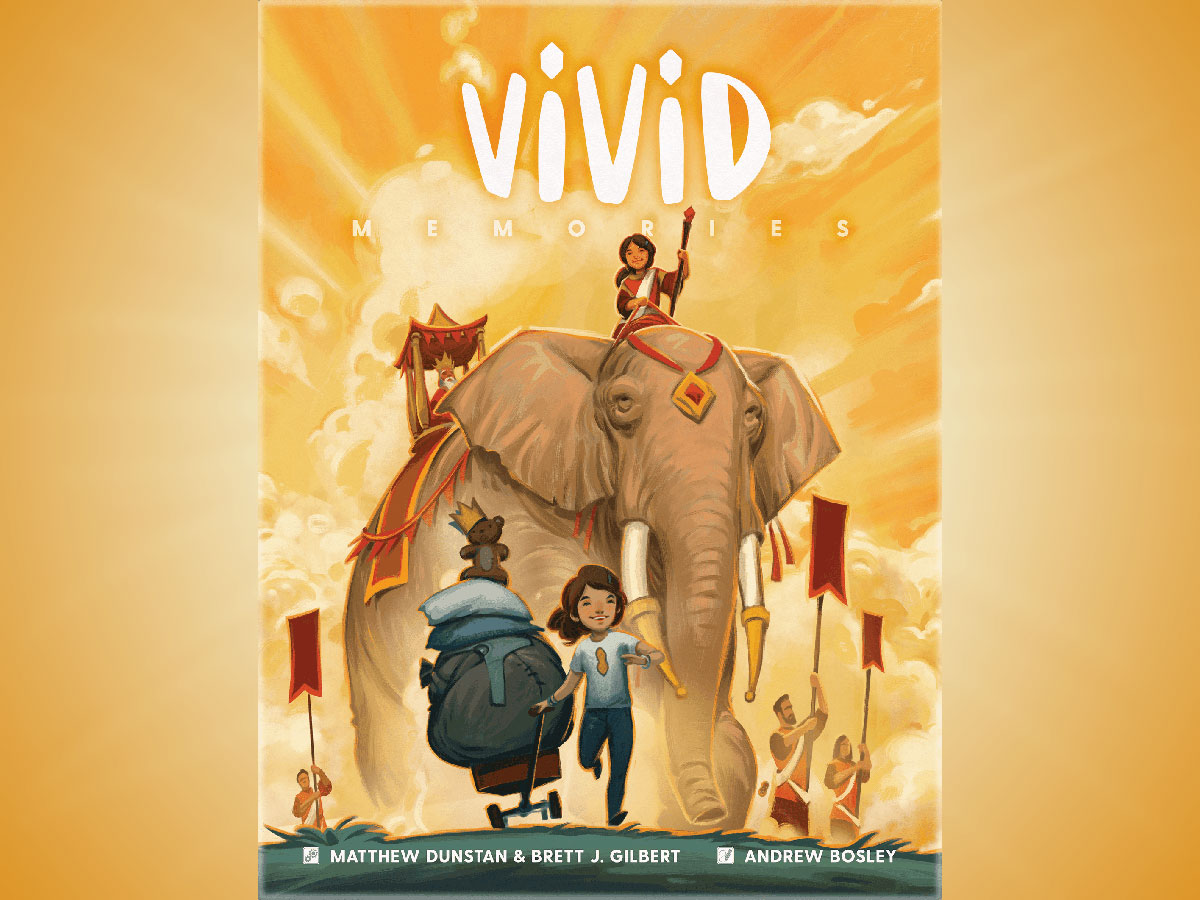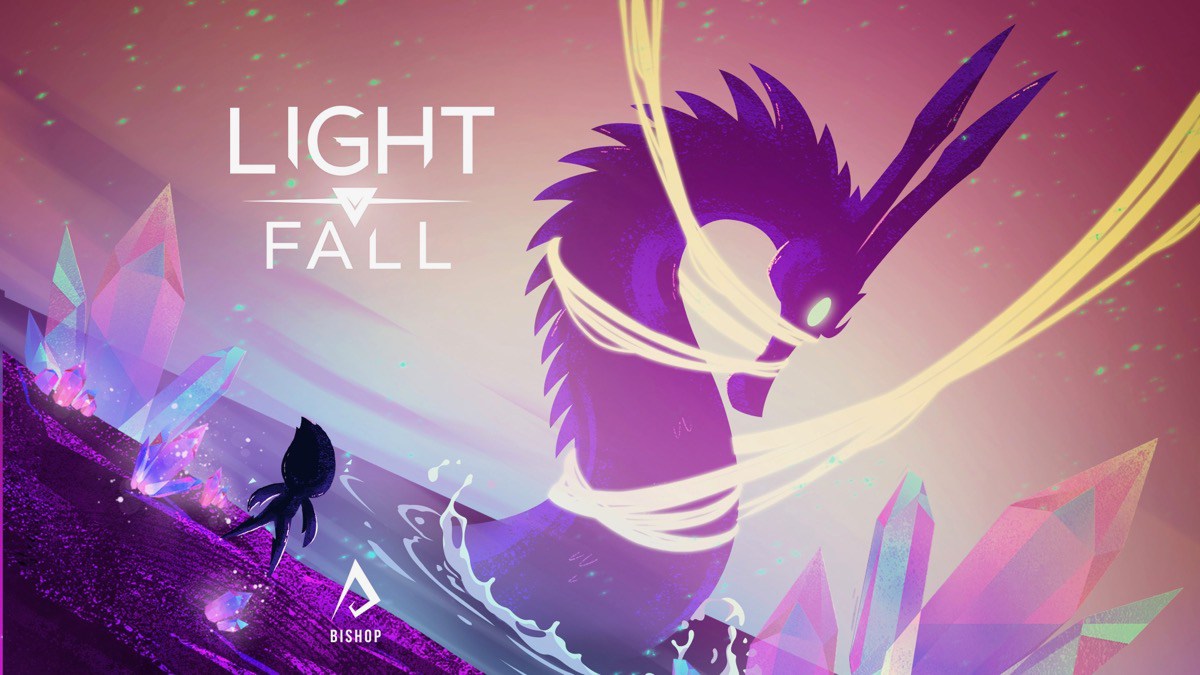Weave together childhood moments to create connections and core memories, while working toward your aspirations.
What Is Vivid Memories?
Vivid Memories is a game for 2 to 4 players (with an optional 5th player), ages 13 and up, and takes about 30–45 minutes to play. It’s currently seeking funding on Kickstarter, with a pledge level of $50 for a copy of the game. The game’s theme is about kids and their imaginations and is kid-friendly, but the gameplay, which involves manipulating the fragments on a board, could be a bit challenging for younger players. Still, it may be okay for kids under 13 who enjoy spatial puzzles.
Vivid Memories was designed by Matthew Dunstan and Brett J. Gilbert and published by Floodgate Games, with illustrations by Andrew Bosley.
New to Kickstarter? Check out our crowdfunding primer.

Vivid Memories Components
Note: My review is based on a prototype copy, so it is subject to change and may not reflect final component quality. The prototype shown in my photo may not match exactly the final components that will be included in the game. Stretch goals may add or upgrade components if they’re reached. Of note, the Kickstarter deluxe edition will include 5 player boards, but the retail edition will only include 4, with a 5th player board available to purchase separately from Floodgate Games. Also, the memory banks, pictured here as narrow strips, will be integrated with the brain boards in the final game rather than separate components.
Here’s what’s included:
- 5 Brain boards
- First Player tile
- Scoreboard
- Round marker
- 16 Player score markers
- 4 Player Aid cards
- 5 Private Aspiration tiles
- 20 Moment tiles
- 125 Fragment tokens
- Cloth bag
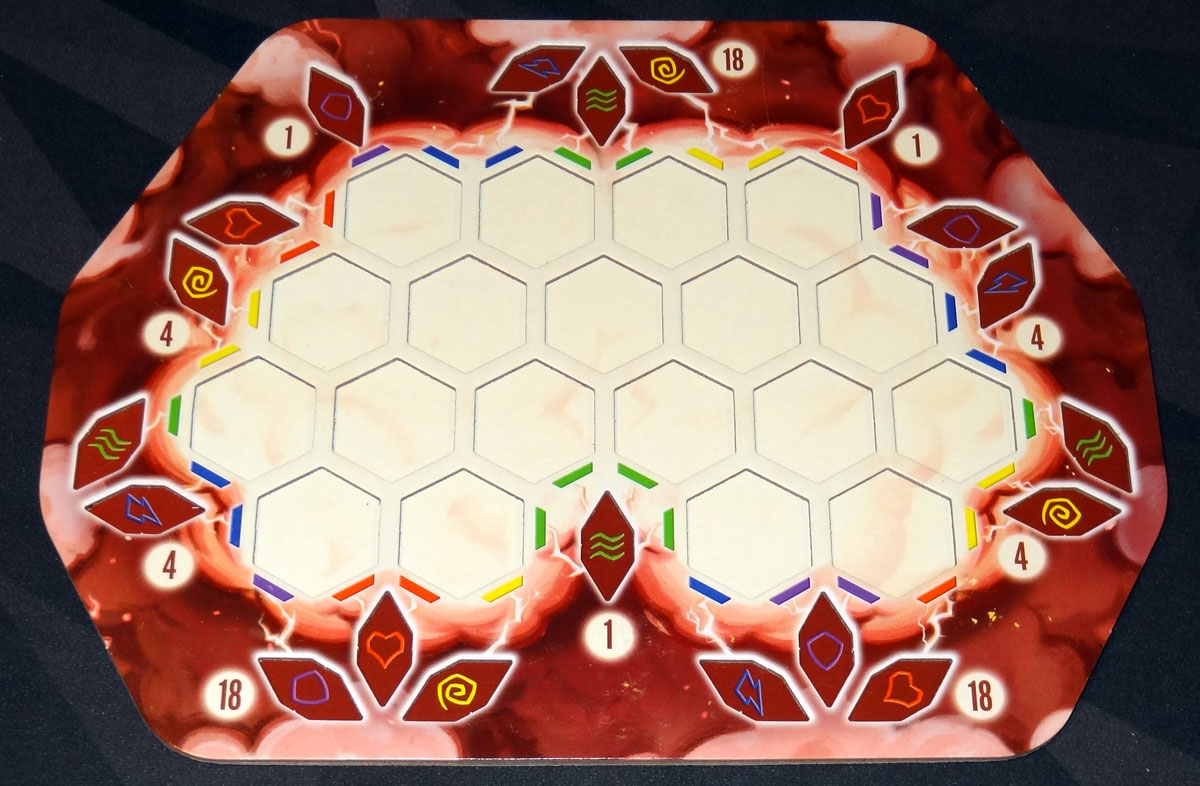
The player boards represents your brain and is where you will be placing and arranging memory fragments. The board is dual-layered, with recessed hexes that can each hold up to 3 fragments, and the “Core Memory” spaces around the edge are also recessed to fit the fragments. Although everyone’s board has the same scoring layout, the order of the colors in the Core Memory spaces is different on each board.
The memory bank boards will be built into the top of the brain boards in the finished game instead of as a separate strip.
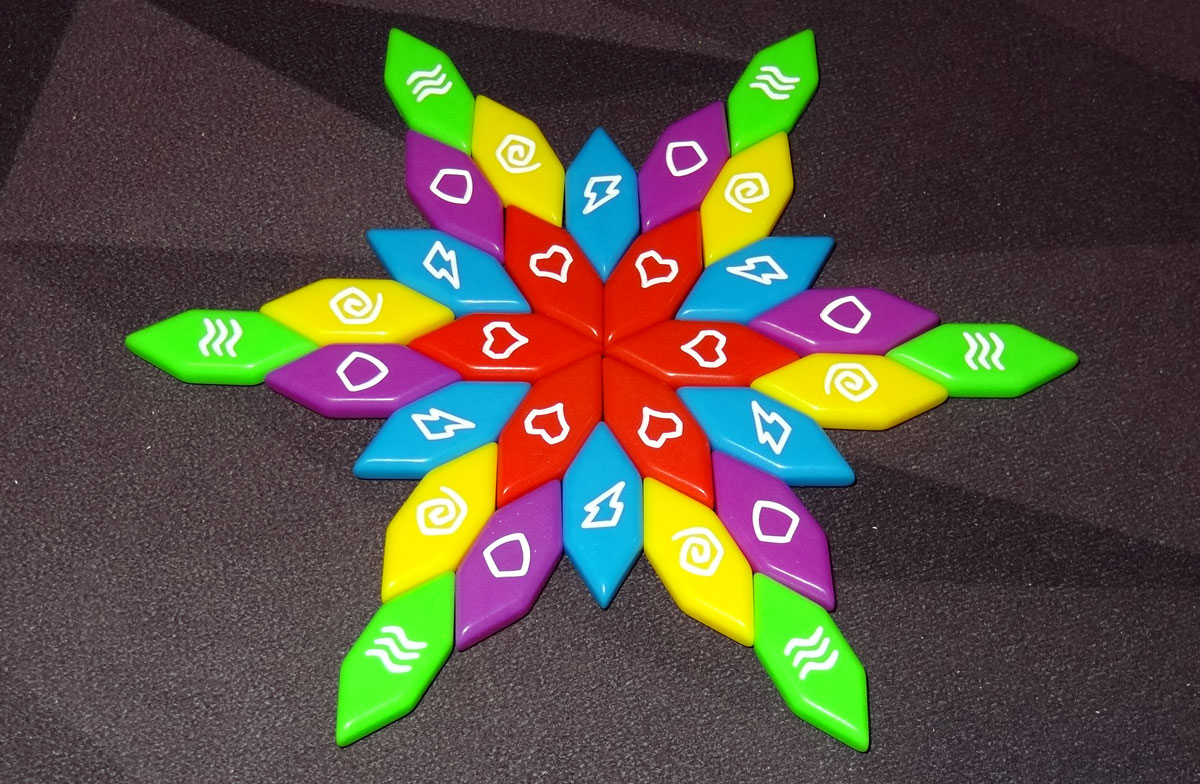
The memory fragments are plastic pieces, a stretched hexagonal shape with rounded edges. They come in five different colors, and each also has an engraved icon on it as well, helping to distinguish the colors. These icons are also used on the boards and cards. The fragments are colorful and fun to play with, and the brain boards are designed so that three of them fit in a hex but not necessarily the way you’d expect (see the icons on the moment tiles below). They can be a little slick, so the dual-layered boards are definitely helpful to keep them from sliding all over.

The moment tiles are long hexagons, and they have some wonderful artwork on them. On the front of each is an illustration of a kid doing something—fishing, climbing a tree, riding a bike. On the back, there’s an illustration showing the kid is picturing in their imagination: sometimes it’s a realistic activity that an adult would do, and sometimes it’s totally fantastic. Each tile also has an ability at the bottom on the front, and a scoring effect on the back.
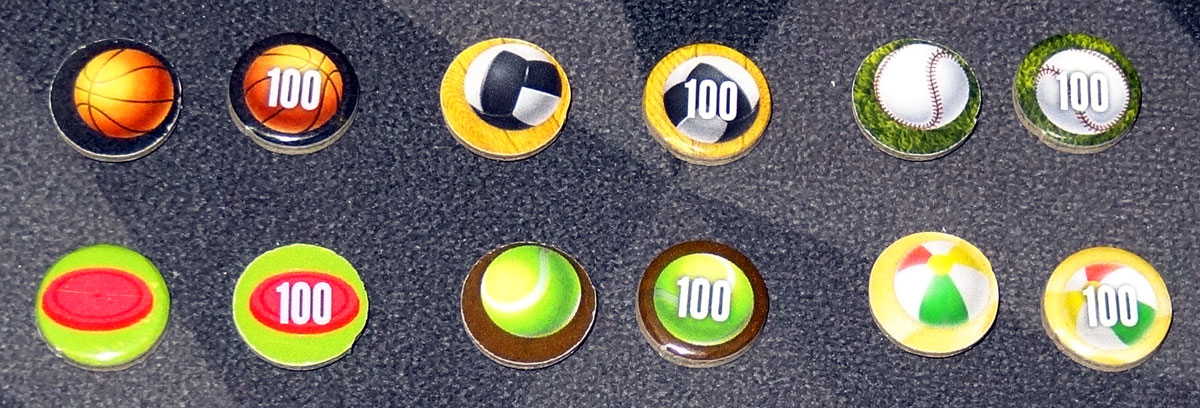
The scoring tokens are small round tokens, each with a picture of a ball (or other round object like a frisbee). The back of the token has “100” printed over the ball, in case you wrap around the score track. The prototype included two of each ball, so that you could put one on the scoreboard and keep the other near your board, but I’m not sure what exactly the final game will have, since the prototype included 24 tokens total but the Kickstarter page lists 16. The tokens fit on the spaces on the scoring track and are quite small.
How to Play Vivid Memories
The Goal
The goal of the game is to score the most points over three rounds by collecting arranging memory fragments to make connections and build memories.
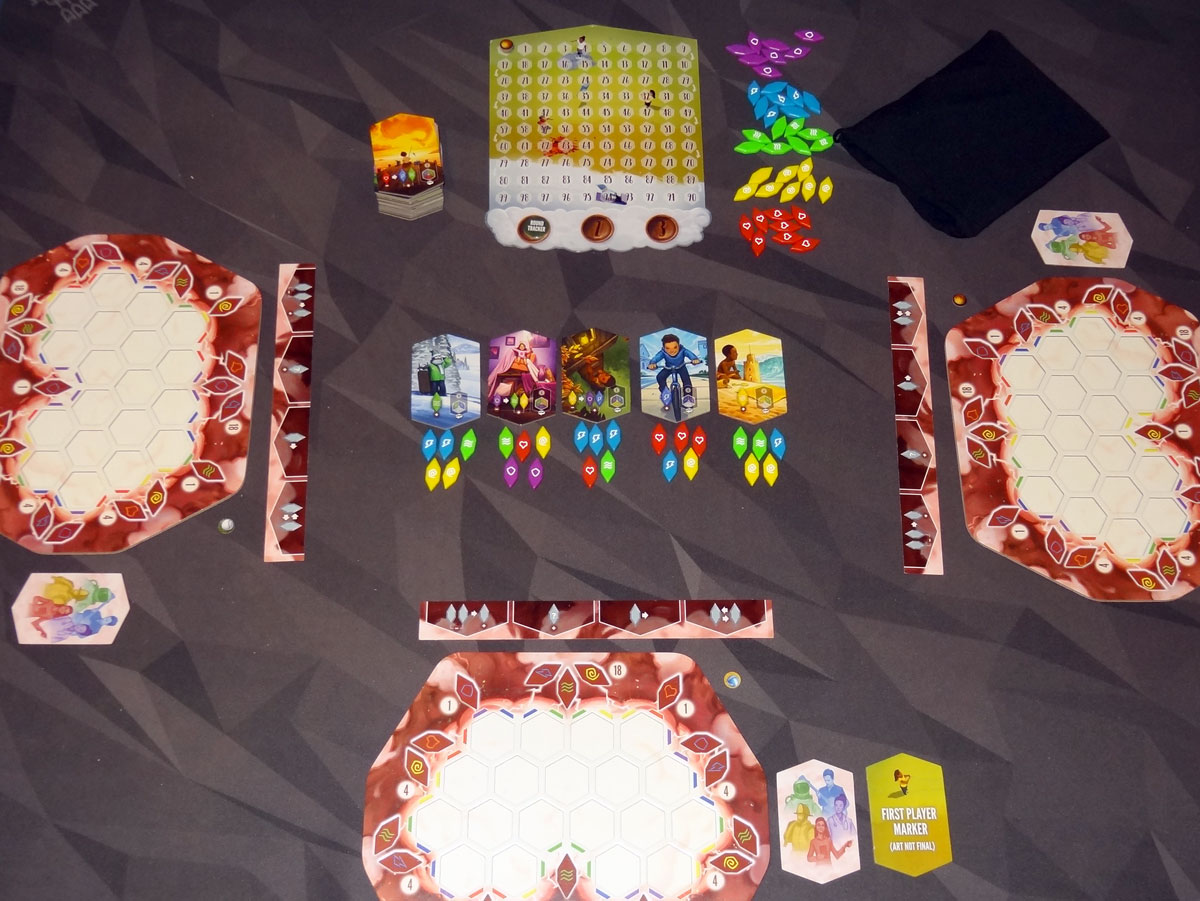
Setup
Give each player a brain board, a memory bank (placed above the brain), and an aspiration tile (which is kept secret from other players). Place the scoreboard to the side, with each player’s chosen scoring token at 0. Give the first player tile to the player who can recall the earliest positive memory.
Shuffle the moment tiles and place them in a stack. Put memory fragments into the cloth bag—the exact number is based on the player count, and the rest are set nearby as a supply.
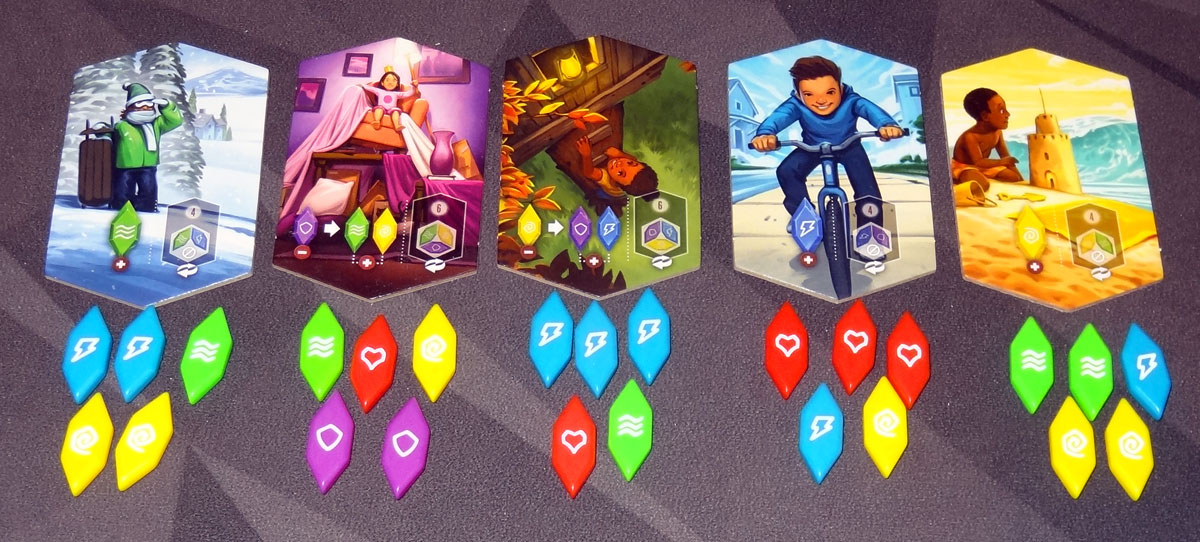
Gameplay
At the beginning of each round, you “Prepare.” You’ll first lay out a line of moment tiles in the center of the play area, with 2 more tiles than the number of players. Then, you’ll draw fragments out of the bag to place on each tile (4 or 5 depending on player count). We found that placing them below the tiles rather than directly on them let us enjoy the artwork a bit more, and also made the fragments a bit easier to see.

Then, players will take turns claiming fragments until they’re all gone, in the “Remember” phase.
You may take 1, 2, or 3 fragments from one end of the moment line. If you take 2, they must both be the same color, and if you take 3, they must be all different colors. If you empty a tile by taking 1 or 2 tiles, you may continue taking from the next tile (still following color rules). If you empty a tile, you also take the tile and place it near your brain board.
Place all of the fragments you collected this turn in one space of your brain board. If you took only 1 fragment, you may now do a rewire action: either choose a space and move any number of fragments from adjacent spaces into it, or choose a space and move any number of fragments from it into adjacent spaces. (There’s a maximum of 3 fragments per space.)
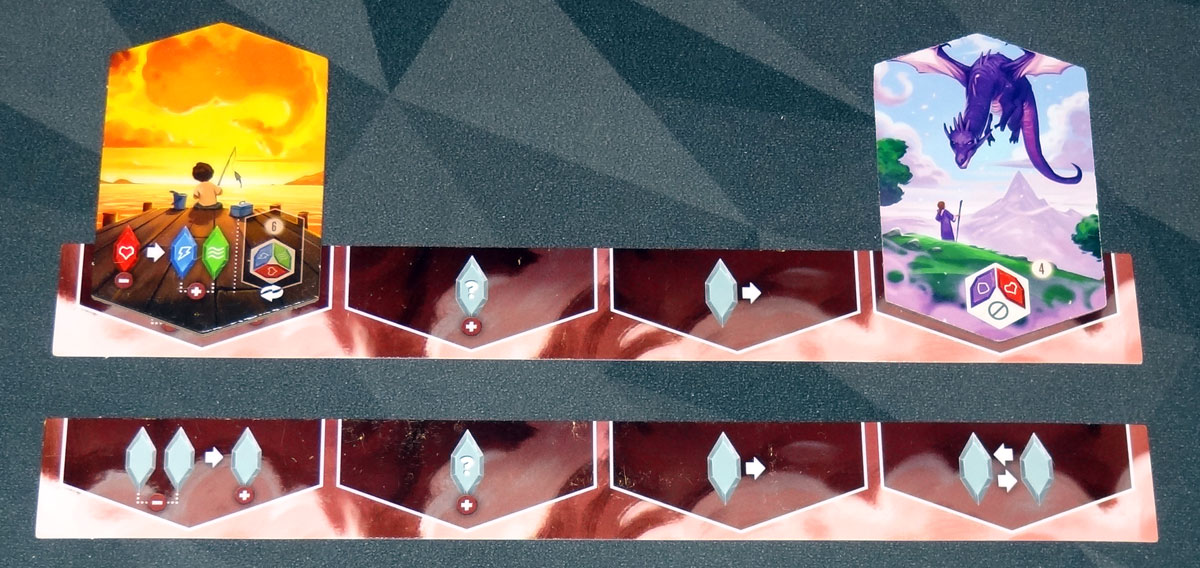
Once all of the moment tiles have been claimed, give the start player token to the player left of the person who took the last fragment. (So turn order will be preserved when you start the next round.)
Now it’s time for the “Reflect” phase, which everyone does simultaneously. Place any moment tiles you have collected into slots in your memory bank, covering up the effect printed on the slot. Then, you may use each slot in your memory bank once. The four basic actions in your memory bank are:
- Remove 2 fragments from a space and trade them with any one fragment from the supply.
- Draw a fragment from the bag and place it into any empty space.
- Move 1 fragment into an adjacent space.
- Swap 2 fragments that are in adjacent spaces.
If there is a moment tile in a memory bank slot, then you cannot use that basic action, but you can use the action printed on the tile. There are two types of actions:
- Take a fragment of the indicated color and add it to an empty space.
- Remove the indicated color of fragment and replace it with the two indicated fragments.
When you use the ability on the moment tile, it flips over to the scoring side, but remains in that slot until you score it. (If you choose not to use the ability on the moment tile, it stays there and may be used in a future round.)
Once everyone has completed their actions, you “Score.”
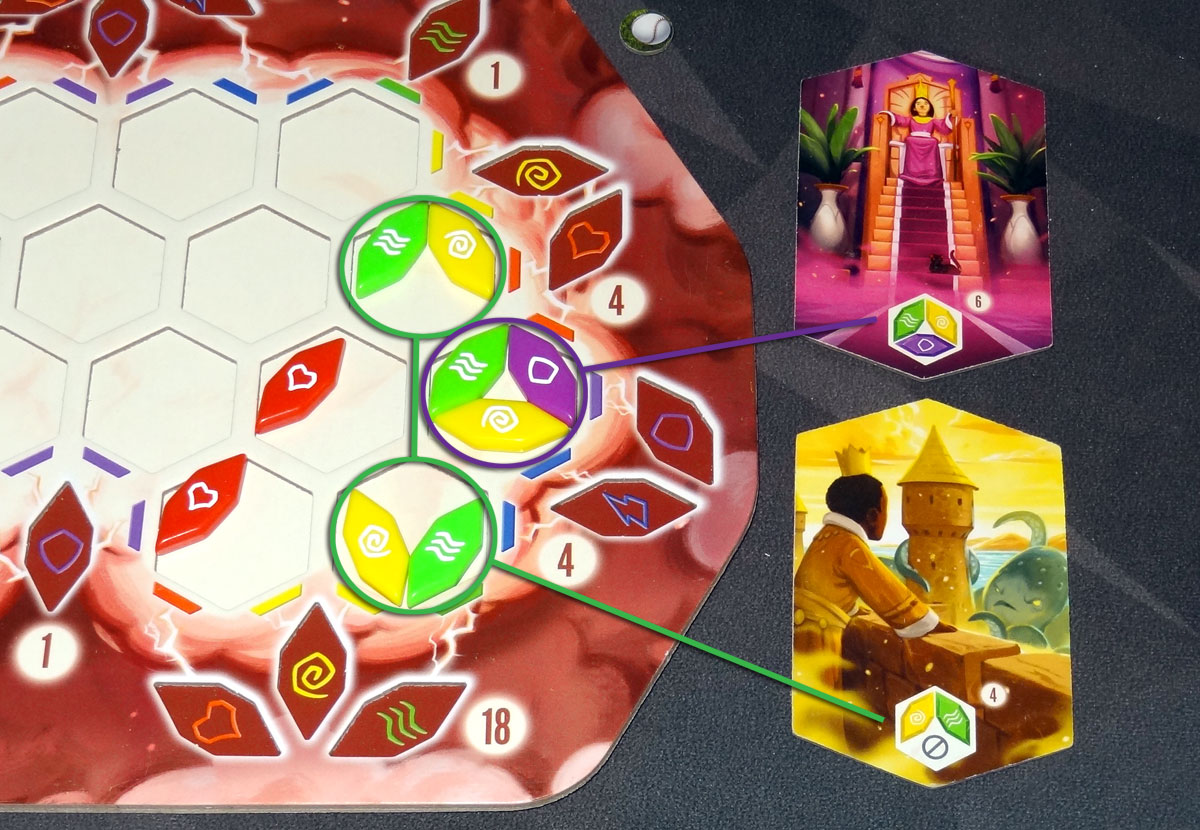
First, check each of your moment tiles that has been flipped over—there will be a hex with either 2 or 3 fragments in it. For each space on your board that matches the tile, you score the points indicated. (The orientation of the fragments doesn’t matter, just the colors present.) Once you have scored a moment tile, remove it from your memory bank and set it aside in a scoring pile.

Then, you look for connections. Around the outside edge of the brain board are core slots with specific colors—these colors also appear on the edges of the border hexes. If there’s a continuous path of hex spaces connecting two or more of the same color core, all containing at least one fragment of that core, then you’ve created a thread. Each thread scores for the number of hexes (not fragments) in the thread, multiplied by the number of empty slots connected. Count all of the hexes connected in the thread, even if it’s not the shortest path. In the example above, there are four hexes connecting two slots, so the player scores 8 points. After scoring a thread, move a fragment from each end into the core slots. The rest remain on the board.
Finally, you score for core memories. The core slots are grouped in clusters of 1, 2, or 3 colors, which are worth 1, 4, and 18 points, respectively. If you have filled a cluster, you score the indicated points (even if you have scored for that cluster in a previous round).
Game End
The game ends after the third round. After scoring is completed for the last round, players also score for their private aspirations.

The aspiration tiles show your dream job—from teacher to rock star to scientist—and have one of the five colors indicated on it. You score 1 point for each fragment of your color in a hex space on your board, 2 points for each fragment of your color in a core slot, and 5 points for each moment tile in your scoring pile that has your color in its scoring pattern.
The player with the highest score wins. Ties go to the player with more points from their aspiration, and then in reverse player order from the start player in the final round.
Why You Should Play Vivid Memories
I’m definitely on a puzzle-game kick these days. There’s something deeply satisfying to me about arranging pieces—whether they be tiles, cards, or tokens—to create patterns or connected areas, trying to maximize scoring in multiple directions. Vivid Memories is another game that scratches that itch, this time with a theme that’s reminiscent of the film Inside Out, as you handle memory fragments and build core memories. Floodgate Games is also the publisher behind Sagrada, another colorful puzzly title, and I think Vivid Memories is a nice companion to it, though it feels a little more complex than Sagrada.
There are several things you have to consider when you’re collecting fragments on your turn: first, how many fragments to take? Taking a pair of the same color could be great if you can work toward your aspiration, or to get more of a color so you can rearrange them later to build a thread. And of course, getting three fragments just gives you more to work with—even better if those three happen to line up with a pattern on one of your moment tiles. But taking a single fragment lets you rewire, moving things around, which is often crucial to building those scoring patterns and threads. The hard part is, if you’re taking one fragment a turn and the other players are taking two or three at a time, it can feel hard to catch up, not to mention they may snatch up more moment tiles than you.
That’s another consideration: what do you leave behind for the next player? Collecting and scoring moment tiles can be a significant part of your score (especially those 5 points for matching your aspiration color), so you don’t want to make it too easy for other players. It can feel a bit like that game about picking up pennies from the different rows, where you don’t want to be left with the last penny. Here, you don’t want to set things up so that the next player can easily snag a moment tile, especially one that you’d like for yourself.
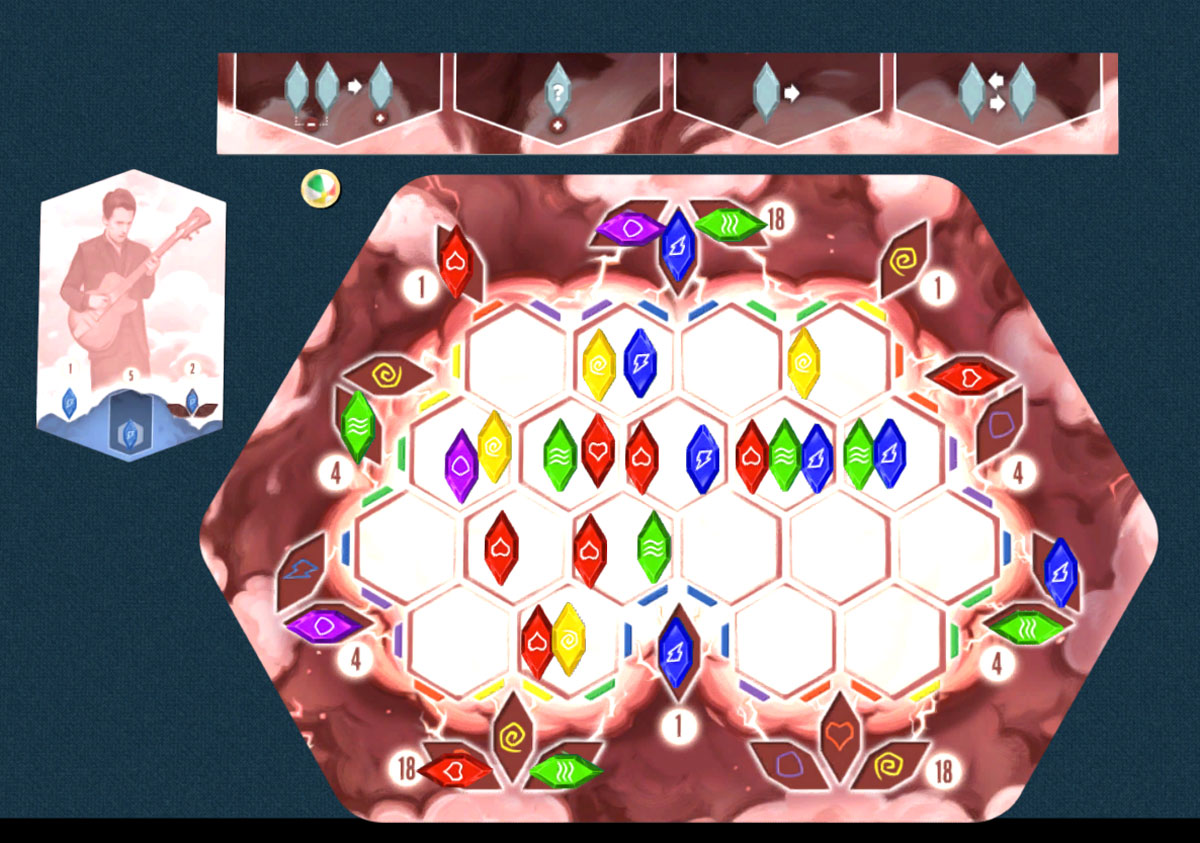
Scoring those moment tiles is important, because they take up space in your memory bank and block a basic action. You can save an ability and use it in a future round, but that still blocks the basic action for this round. Ideally, when you take a moment tile, you want to be able to use the ability and score it in the same round. (Also important: you can’t score a moment tile unless you’ve used its ability to flip it over, so be sure you’re able to take advantage of that!)
Since there are various ways to score points, you have to decide which approach you want to take. For instance, complete core memory groups will score at the end of each round, so if you manage to build a connection to a 4-point group in the first round, that’s 12 points you’ll earn over three rounds! (I tried working on an 18-point group in one game, but it’s really hard to get all 3 threads built in the first round.) You also get a one-time scoring bonus in the round when you complete the thread, and it’s a multiplier based on how many empty slots the thread touches. So it could also be worth it to build out a big network that’s almost touching several slots, and then try to connect them all in the same round to boost that multiplier.
The game is only three rounds, so you have to make the best of a limited number of actions (and that means between your moment tiles and basic actions, you’re only going to get so many of those as well). If everyone is taking single fragments, you may have plenty of chances to rewire and move things around. But if everyone is grabbing three at a time, then that means fewer rewires for everyone, and your board may not be as carefully arranged.
There is some random chance involved, of course, because of the order that the moment tiles arrive and the fragments that are randomly drawn from the bag. Some rounds, there might be very few tokens of a color you were hoping to get, or maybe the moments that you’re able to take don’t have your aspiration color on them. But generally, the number of fragments in the bag is pretty close to the total number that you’ll use over the course of the game, so there are usually roughly the same number of each color used—they just may not appear in the moment line at the times you wish.
Much of the puzzle of Vivid Memories comes from the fact that you’re not just drafting and placing the fragments, but that you can also use the rewire actions and the memory bank abilities to rearrange things. Figuring out how to get the fragments you want, in the places you want them, takes a lot of planning that is easily disrupted when other players pick up fragments or moment tiles you were hoping for, so it also requires the ability to shift your plans in response.
My plays of Vivid Memories were all in Tabletopia (it was a private demo for reviewers so I’m not sure if it will be publicly available), and there were some limitations there—it’s a bit harder to keep an eye on what your opponents are doing, and the fragments only rotate at 90-degree increments so they don’t fit nicely onto the board the way the real tokens would. But even so, I really enjoyed the game and am looking forward to playing the physical version once it’s safe to get together again. (Soon!) For those who enjoy spatial puzzles, Vivid Memories is a fun head-scratcher with delightful artwork.
For more information or to make a pledge, visit the Vivid Memories Kickstarter page!
Click here to see all our tabletop game reviews.
![]() To subscribe to GeekDad’s tabletop gaming coverage, please copy this link and add it to your RSS reader.
To subscribe to GeekDad’s tabletop gaming coverage, please copy this link and add it to your RSS reader.
Disclosure: GeekDad received a copy of this game for review purposes.
